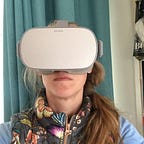The Taxonomy of Experience: Part 4
A universal language for categorizing IRL and XR experiences.
Interpersonal Point of View
In Part 3, we’ve just discussed all five senses and how they might function in extended reality experiences. Whatever point of view a sense brings, it is a one-way relationship; it’s about how one perceives something: sight, sound, smell, touch or taste. But we also know that extended reality is a medium in which the viewer-participant can have an impact.
In Part 1, we discussed effectual POV, which accounts for the impact a viewer-participant may have on a story or scene. We also discussed posemperic (f.k.a. experiential) POV, which accounts for how a viewer-participant might impact their own experience of a story or scene.
What we have yet to discuss — and will discuss presently — is how a viewer-participant might affect another viewer-participant’s experience of a story or scene.
Ineffective Interpersonal POV
An ineffective interpersonal POV experience is one in which the viewer-participant has no interaction with other viewer-participants. Characters or actors in an experience aren’t considered viewer-participants, so in an ineffective interpersonal POV experience, the viewer-participant may have interaction with live actors, recorded performers, or AI; the potential impact of these interactions are accounted for by effectual POV, which indicates the…
